What do you get when art meets horticulture? Bonsai trees! The miniature trees typically planted in a pot or tray have been admired and popularized for centuries as a form of living art. Any tree species can be used to cultivate a bonsai; there is no genetic dwarfism in bonsai plants. However, it is easier to compose the arrangements using plants with smaller leaves.
Although bonsai is a Japanese word translated as planted in a container, the beauty and artistry of bonsai trees originated from an ancient Chinese practice known as penjing. The Japanese adapted penjing into bonsai. However, there’s a slight difference between the two.
Penjing creates a more naturalistic setting, more like landscape scenes, by incorporating things such as rocks, but bonsai features a more refined, controlled depiction of nature with aesthetically-displayed mini replicas of a tree or group of trees of the same species.
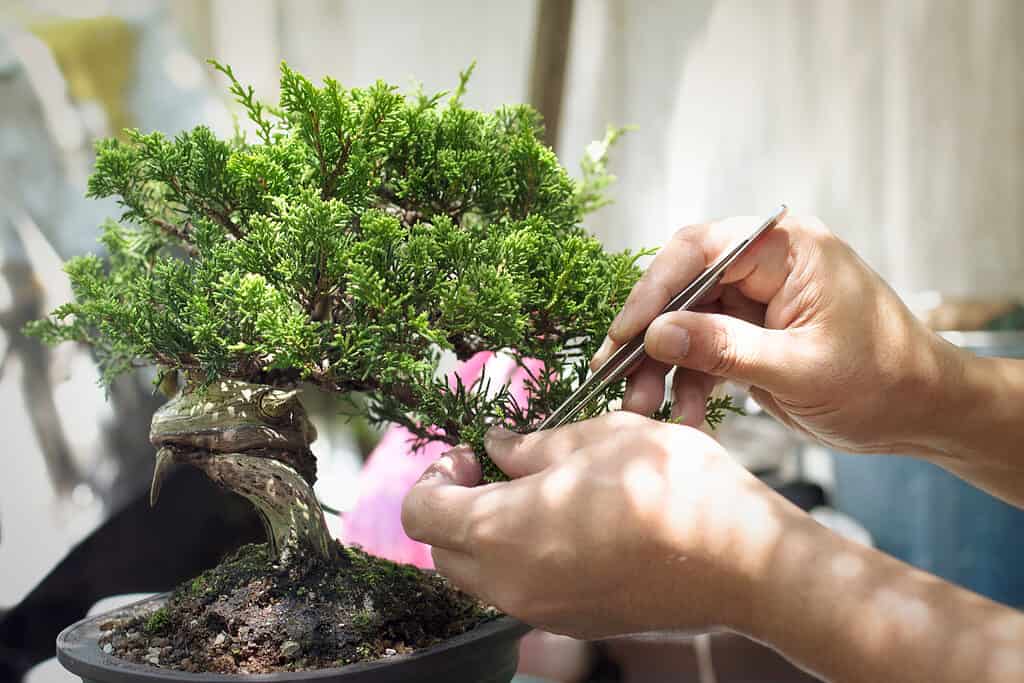
The miniature trees typically planted in a pot or tray have been admired and popularized for centuries as a form of living art.
©qSPOoKYp/Shutterstock.com
Longevity
Beyond their beauty appeal, bonsai trees are renowned for their longevity. The tree species, level of maintenance, and environmental factors all affect how long they live. While certain bonsai tree species, like juniper and pine, can live for more than 100 years, others, like maple and oak, only live for 50 to 60 years.
A bonsai tree will often live longer if cultivated in a warm environment with lots of sunlight than if planted in a cooler region with less sunlight.
Value
If you know only one thing about bonsai trees, it’s most likely their premium value. The painstakingly planted trees are a testament to patience and tenacity; they need daily monitoring, frequent watering, and all-around care to flourish.
The expertise needed to grow these trees contributes to their worth; it takes years of, among other things, trimming, re-potting, and grafting to craft a bonsai tree. As you can tell, it takes time to become proficient in the required procedures, and any mistakes might kill the plant or alter its shape.
Some bonsai trees are harder to grow. Thus, they will carry a higher price tag. In addition, the tools and bonsai pots used are often handcrafted and expensive.
Here are the top 7 most expensive bonsai trees ever sold.
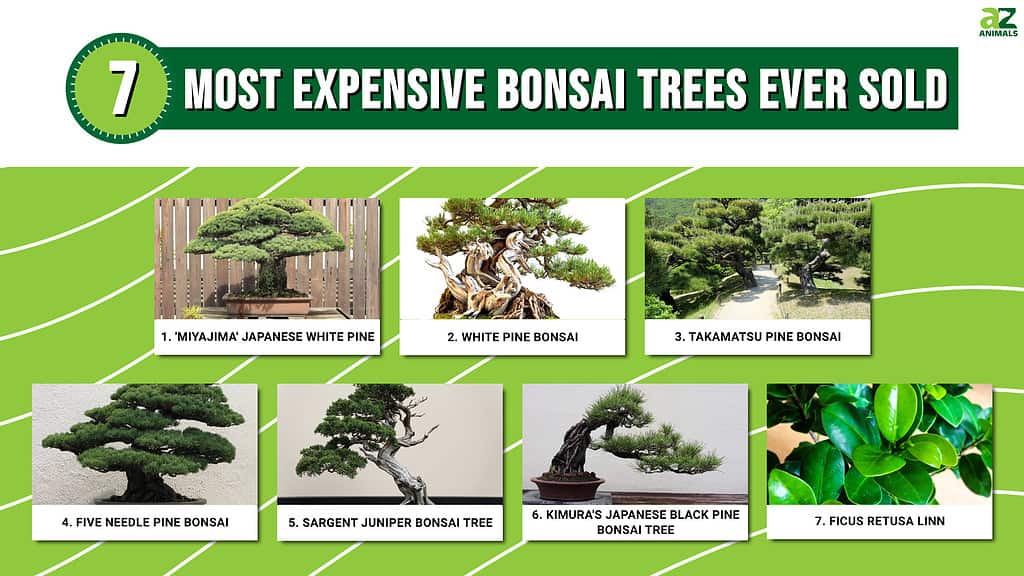
1. ‘Miyajima’ Japanese White Pine: $1.3 Million

The Miyajima Japanese White Pine was cultivated by a well-known artist.
©Creative Commons Attribution-Share Alike 3.0 – Original / License
A Japanese white pine Bonsai tree sold for $1.3 million at the 2011 International Bonsai Convention broke all previous records. A well-known Bonsai tree artist named Seiji Morimae sold it to a Japanese private collector.
The tree is a ‘Miyajima’ dwarf pine tree cultivar, a majestic specimen with lofted leaves, a strong, curving trunk, and an aged appearance. The age of this Bonsai tree ranges from 300 to 800 years, depending on the source.
Even though bonsai trees were trendy in 2011, this specific example is still lovely and worth the money. Morimae is said to have also bought a special pot for this tree, which probably increased the total cost.
2. White Pine Bonsai: $1.3 million

The over 800-year-old white pine bonsai is one of the most expensive in the world.
©Bernd Schmidt/Shutterstock.com
This over 800-year-old white pine at the Shunkaen Bonsai Museum, owned by Master Kunio Kobayashi, is one of the most expensive bonsai trees in the world. Kobayashi runs the Shunkaen Bonsai Museum in Tokyo, and it cost him $1.3 million to acquire the tree for the museum.
The tree is displayed at the Shunkaen Bonsai Nursery in its classic tokonoma. Interestingly, Kobayashi has been a bonsai practitioner for 30 years and has since become a master with a renowned bonsai school and a museum. He has won the prestigious Prime Minister award in Japan four times. Apprentices and international students who learn this old craft are accommodated in his museum along with more than 1,000 beautiful trees.
3. Takamatsu Pine Bonsai: $1.3 million
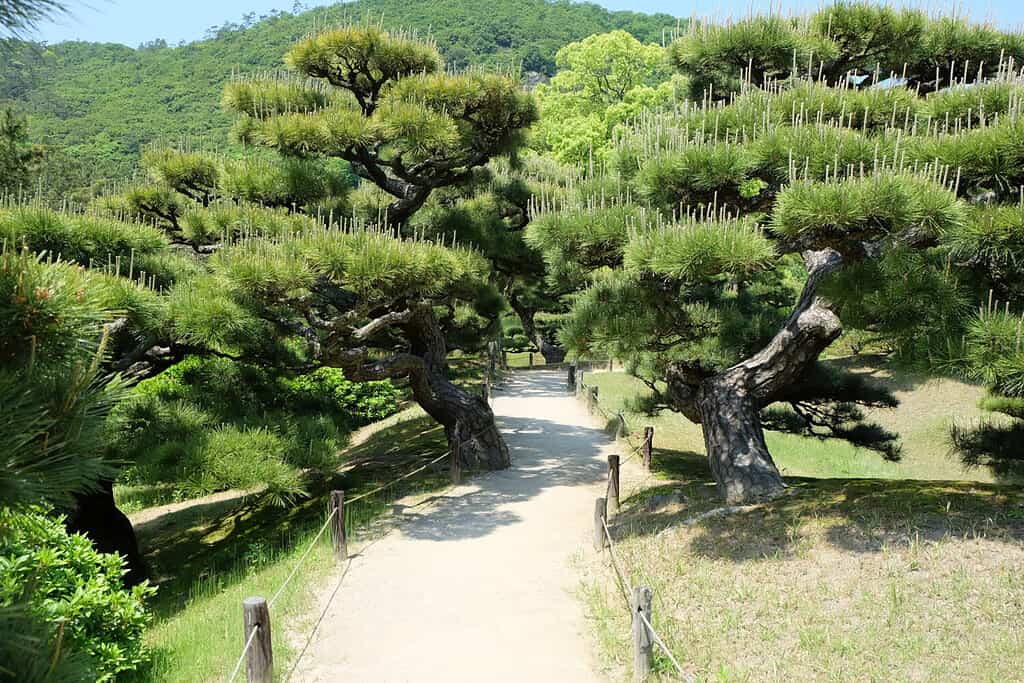
Pine trees aren’t a good choice for beginners, but they are one of the most popular bonsai trees.
©Archcultures/Shutterstock.com
Another 800-year-old bonsai was sold at the Takamatsu International Bonsai Convention in 2012 for 100,000,000 Japanese Yen (about $1.3 million at the time). The perfectly shaped Japanese white pine has all the characteristics of a mythical tree that one might discover in a primeval forest, including a massive, twisted trunk, gnarled bark, and a full canopy. Yet, except for one tiny detail, the bonsai was less than a meter tall.
Pine trees aren’t a good choice for beginners, but they are one of the most popular bonsai trees. They can be shaped into almost every known bonsai style because they exist in various colors, forms, and sizes.
4. Five Needle Pine Bonsai: $600,000
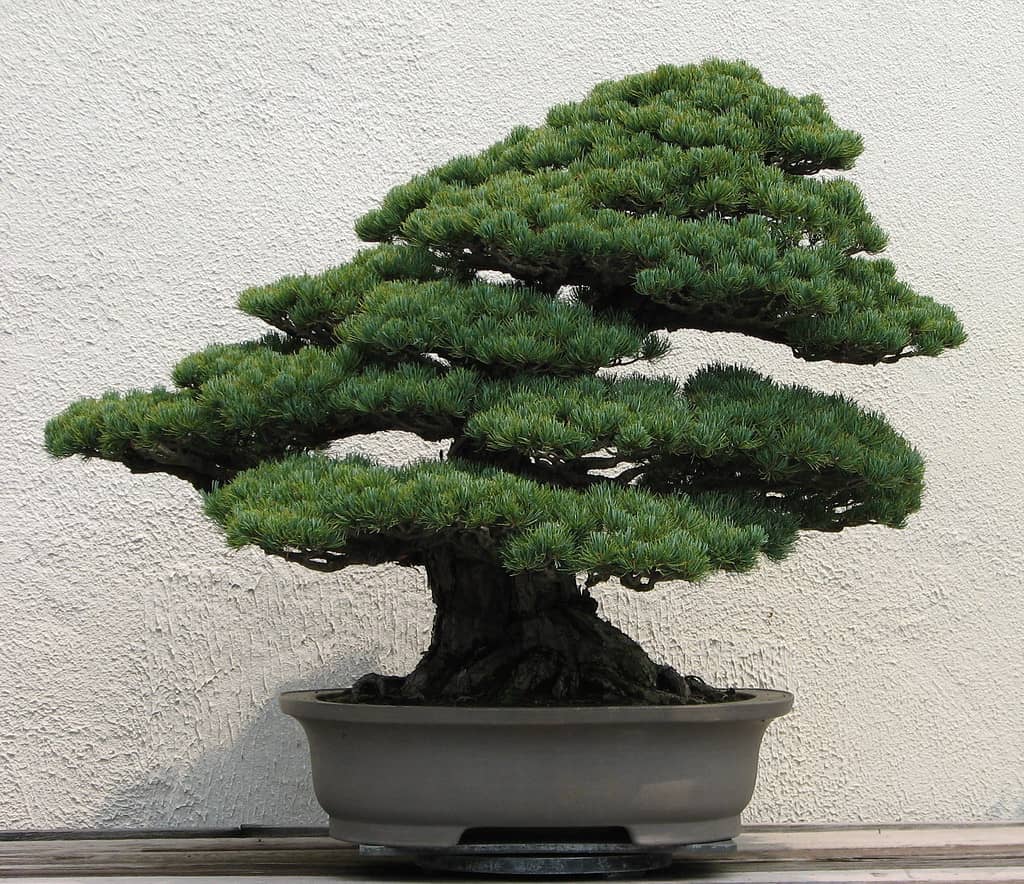
This tree is renowned for its large crown, small flowers, and, most importantly, extraordinary growth rate.
The five-needle pine, also known as Japanese white pine and Ulleungdo white pine, is an evergreen conifer with prickly leaves that grow in five bunches. This tree is renowned for its large crown, small flowers, and, most importantly, extraordinary growth rate.
It can grow up to two feet (24 inches) every year. For context, a bonsai tree typically grows about 17 inches a year. However, some trees, such as Jade bonsai, only grow 2 inches yearly. Thus, five-needle pine bonsai trees are one of the fastest-growing and tallest in the world, which adds to their premium price.
Five needle pine bonsai trees are usually centuries old; the one auctioned off for $600,000 in Japan is estimated to be about 300 years old.
5. Sargent Juniper Bonsai Tree: $350,000
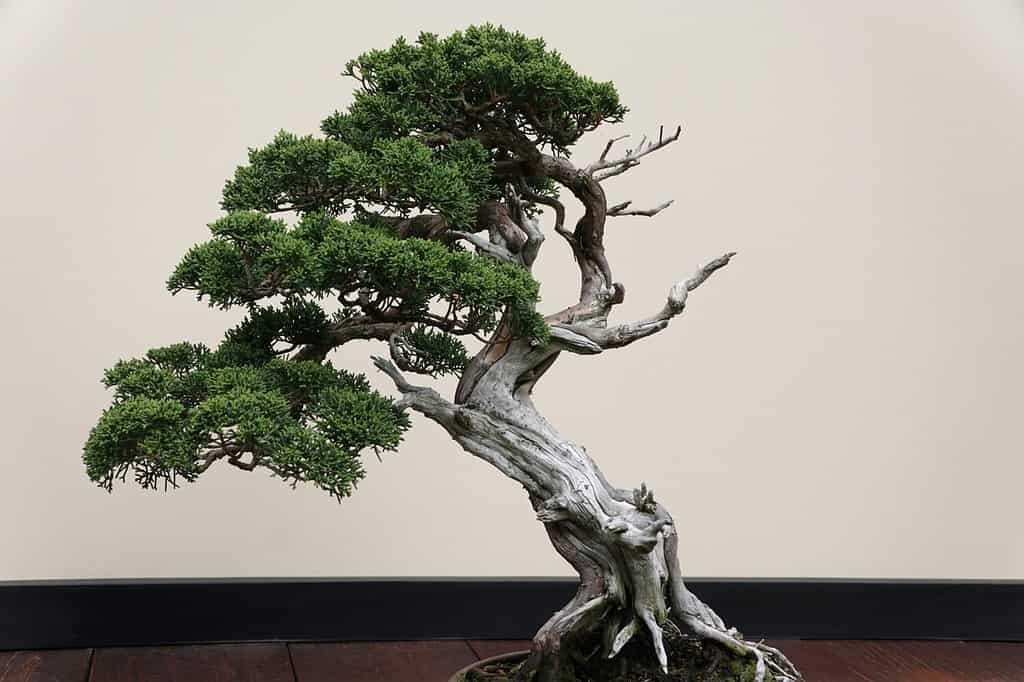
©Khairil Azhar Junos/Shutterstock.com
This Sargent Juniper bonsai tree sold for $350,000 at an auction during the Taikan-ten Bonsai exhibition in Kyoto, one of the biggest bonsai festivals worldwide. The annual exhibition in November features unique bonsai for sale alongside the scrolls and suiseki that accompany its customary display methods. The most outstanding bonsai of the year receives the Prime Minister Award.
Pruning a Sargent Juniper bonsai tree is quite easy with standard techniques, and the tree embodies the distinctive profile that characterizes the art. This makes it a top contender for the most popular bonsai breed. When the National Bonsai & Penjing Museum opened its doors in 1976, it displayed more than 50 bonsai trees, all of which were Sargent Junipers. The tree is even the museum’s logo.
They’re also among the oldest and rarest bonsai trees. The oldest juniper bonsai is a stunning 1000-year-old tree belonging to the Kato Family. The legendary tree is at the Mansei-en Bonsai garden in Omiya, Japan. The garden is close to the Omiya Bonsai Art Museum and has been managed by the family since the 19th century. This tree, unfortunately, is not for sale.
According to family lore, the tree was discovered in a forest by their ancestors. They started caring for it and passed it on to their descendants until it survived a millennium.
6. Kimura’s Japanese Black Pine Bonsai Tree: $106,000

The Taikan-ten exhibition in Kyoto, Japan, in 2015 awarded the top prize to this black pine.
©Lilly Kauffman/Shutterstock.com
Masahiko Kimura, whose garden could be mistaken for a museum, is one of the influential Japanese bonsai artists. Many bonsai art enthusiasts can easily identify his works in magazines and websites.
With its commanding presence, dense canopy, and huge trunk, Kimura’s Black Pine bonsai, which sold for $106,000, is perhaps his most infamous piece. The tree also leans to the right; the apex and main branch point in that direction.
Despite his fame for juniper bonsai, Kimura also does excellent work with pine. The Taikan-ten exhibition in Kyoto, Japan, in 2015 awarded the top prize to this black pine.
7. Ficus Retusa Linn: $91,000

Ficus retusa linn is believed to be more than a thousand years old.
©Luca Piva/Shutterstock.com
After ten years of unsuccessful attempts to get ownership of this ficus retusa linn bonsai tree, Luigi Crespi, owner of the Crespi Bonsai Museum in Italy, eventually bought it in 1986 for $91,000.
The tree is displayed in a glass pagoda basking in sunlight at a central point in the museum. It was originally planted by Chinese artisans, but Japanese bonsai artist Shotaro Kawahara pruned it when it arrived in Italy.
Other Valuable Bonsai Trees in the World
Yamaki Pine Bonsai
The 398-year-old Japanese white pine is about two feet high and has a thick trunk and short needles. It was donated to the National Arboretum’s Bonsai and Penjing Museum in 1976 by a bonsai expert Masaru Yamaki whose family owned the tree. The tree was one of the 53 species gifted to the United States. It was given in honor of the country’s bicentennial anniversary of its independence, which was commemorated that year.
Although it’s deemed priceless and has yet to be sold since the Arboretum acquired it, the tree is thought to be worth about $1 million. This tree’s survival in Hiroshima during the aftermath of the 1945 atomic bombing is what makes it even more unique. Following the explosion of the bomb, a Japanese news crew captured footage of the devastated Yamaki Nursery. The tree was still there, visible in the distance.
In March 2001, Yamaki’s grandchildren Shigeru and Akira visited the Arboretum and helped them rediscover the tree’s history.
Kimura’s Zelkova Bonsai
Masahiko Kimura’s works are legendary; his Zelkova Bonsai looks distinct and is often cited as a famous example of art. In addition, Kimura cares for the iconic plant on display at Omiya Bonsai Village.
The Zelkova Bonsai is a symbol of the 90-year bonsai tradition in the Omiya village with its peculiar grey bark and perfectly symmetrical growth patterns. Of course, this bonsai is one of the highlights of the garden. It’s valued at $106,000, the same price the artist sold his Japanese Black Pine Bonsai tree.
Kimura perfected his artistry during an 11-year tutelage as an apprentice to Motosuke Hamano. His teacher is the master bonsai artist at Toju-en Bonsai Garden.
Shimpaku Juniper Bonsai
A unique 400-year-old Shimpaku Juniper, owned by Seiji Iimura, a fifth-generation bonsai master, is a bonsai superstar scheduled to participate in a Japanese beauty contest. Unfortunately, the rare find, valued over $90,000 was stolen in 2019 alongside three little pine trees, known as goyomatsus, and three less-valued shimpaku trees.
According to a CNN report, the seven bonsai trees are estimated to be worth at least $118,000. They were stolen from Limura’s 5,000-hectare park, which features about 3,000 bonsai trees in Saitama prefecture near Tokyo.
According to Limura, the 400-year-old tree was plucked from a mountain centuries ago. His family reduced it to a miniature size through an extensive understanding of plant psychology.
Tips to Care for Bonsai Trees
Bonsai trees are renowned for requiring high maintenance. But the routine gets better once you get the hang of it. Finding the ideal humidity and watering levels is one of the most challenging aspects of bonsai care.
It’s important to monitor and use the proper watering or misting continuously. Your bonsai will benefit more from on-demand watering as opposed to routine watering.
Placement is key. Ensure the bonsai trees are positioned where they receive direct sunlight throughout the cooler months. They require sufficient bright, indirect light. Avoid placing them in direct heat sources.
Fertilization may seem ironic because bonsai trees are expected to remain small. However, fertilizing is essential throughout the growing season, typically spring and summer. Select a fertilizer made specifically for bonsai to support robust growth.
Bonsai trees are constrained to their containers. Thus, adequate fertilization is needed to restore the soil’s nutritional content.
Conclusion
Bonsai trees are miniature living works of art that genuinely symbolize the height of horticultural talent and patience. Their worth is reflected not just in their price. Their worth is also in recognition of the craftsmanship and hard work that went into creating them.
Summary of the Top 7 Most Expensive Bonsai Trees Ever Sold
| Rank | Bonsai Tree | Price |
|---|---|---|
| 1 | ‘Miyajima’ Japanese White Pine | $1.3 million |
| 2 | White Pine Bonsai | $1.3 million |
| 3 | Takamatsu Pine Bonsai | $1.3 million |
| 4 | Five Needle Pine Bonsai | $600,000 |
| 5 | Sargent Juniper Bonsai Tree | $350,000 |
| 6 | Kimura’s Japanese Black Pine Bonsai Tree | $106,000 |
| 7 | Ficus Retusa Linn | $91,000 |
The photo featured at the top of this post is © iStock.com/Sangwien
Thank you for reading! Have some feedback for us? Contact the AZ Animals editorial team.







